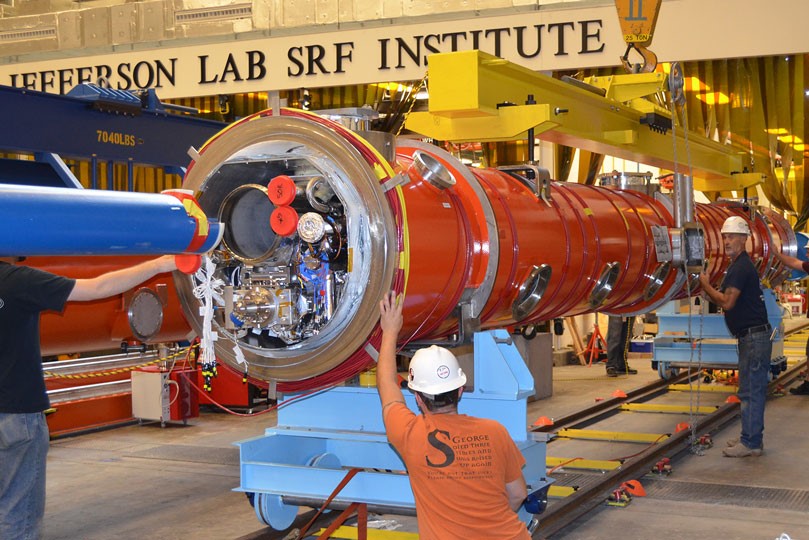Accelerator components built at Jefferson Lab being prepared for the trip to the Linac Coherent Light Source and Stanford Synchrotron Radiation Light Source at SLAC National Accelerator Laboratory.
Nuclear Physicists: Virus Busters
Did you know that nuclear physics is key to finding methods to beat viruses? I’m not talking about computer viruses, I’m talking about the potentially deadly biological kind. Viruses can’t do many things such as move on their own, reproduce on their own, eat, breathe or even die (they are not actually alive), functions that even bacteria can do. What viruses can do is to enter certain living cells via an initial physical attachment to a protein on the cell’s outer surface. Then it releases its own genetic material, using the internal workings and enzymes of the invaded cell to clone itself using the “step by step” instructions in the genetic material. The freshly minted viruses then make their way out of the cell through “budding” out of the cell wall. And then it’s off to the next cell.
When all this happens in infected animals, like humans, the highly developed immune system works quickly, surrounding the infected cells and viruses to contain the infection. Depending on the type of cell infected and the type of virus, this could be a very easy containment or it could be a very deadly problem. I’ve simplified things but this is basically how the immune system puts up road blocks and traps for the virus.
Show Me the Physics
So far I haven’t said anything remotely related to nuclear physics, so here it goes. To explore the tiny bits of matter that make up the atoms of our universe, physicists developed tools like the unique accelerator Jefferson Lab uses to dissect matter at its most basic level, the Continuous Electron Beam Accelerator Facility (CEBAF). The name says it all. An electron beam is made by accelerating a nearly continuous stream of electrons towards a target atom to explore the atomic structure. Electrons are useful for more than just science, powering our homes and giving life to all our electronics. You can see the power of electrons in wonderful displays of lightning during thunderstorms that can scare my dog, and maybe yours as well.
Seeing the Light
So what does this have to do with viruses? While Jefferson Lab scientists use the electrons to explore subatomic particles, scientists at other DOE labs use the circulating beam of electrons to make very intense beams of light of a precise color. These X-rays can be used to unravel the very structure of proteins and other biological molecules. Biologists scatter x-rays off of a protein sample to get an “X-ray scatter pattern” that provides a true picture of the protein molecule that can be used to understand the structures and properties of biological molecules such as DNA and RNA, the very genetic material that is so important to viruses and in fact, all living things. The understanding gained from studying the nature of virus proteins leads to new drugs, vaccines and treatments.
Say “Cheese”
The same types of nuclear physics technology and expertise developed to make the electron beam at Jefferson Lab can be used to take a picture of biological molecules, and the Department of Energy has other laboratories making these types of tools available to researchers from universities and industry. They are the Advanced Photon Source at Argonne National Laboratory, the Advanced Light Source at Lawrence Berkeley National Laboratory, the National Synchrotron Light Source II at Brookhaven National Laboratory and the Linac Coherent Light Source (LCLS) and Stanford Synchrotron Radiation Light Source both at SLAC National Accelerator Laboratory. Currently, Jefferson Lab is applying unique experience and expertise to make continuous electron beams helping SLAC upgrade its facility at LCLS.
So next time you’re in the doctor’s office getting a flu shot to help protect you from a virus, now you can thank not only physicians, but the physicists who are working behind the scenes to help you stay as healthy as you can be.
Tech Tuesday blog posts written by Chief Technology Officer Drew Weisenberger.
https://www.aps.anl.gov
https://als.lbl.gov
https://www.bnl.gov/ps/
https://www-ssrl.slac.stanford.edu
https://lcls.slac.stanford.edu


